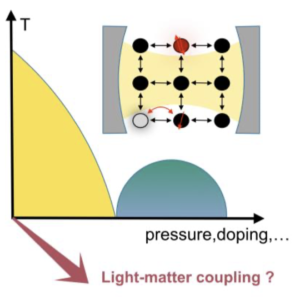D06 – Entangling collective behavior of quantum materials and quantum light
Summary
Condensed matter systems provide a paradigm platform for collective quantum behavior, where intriguing states of matter arise from the interaction between a macroscopic number of degrees of freedom. In this theory project, we aim to develop a microscopic theoretical framework, based on using non-equilibrium Green’s functions and quantum embedding theories, to explore the intriguing possibilities which arise when macroscopic properties of materials are controlled by the quantum electromagnetic field and vice versa. In exploring this direction, project D06 will merge ideas of quantum optics with the rapidly evolving field of classical light-induced phenomena in solids.
Project Leaders
Martin Eckstein
Friedrich-Alexander-Universität Erlangen-Nürnberg
91058 Erlangen
- Phone number: +49 9131 85-28224
- Email: martin.eckstein@fau.de
Publications
2023
- , , , , , , , , , , , , :
Cavity-mediated thermal control of metal-to-insulator transition in 1T-TaS2
In: Nature 622 (2023), p. 487-492
ISSN: 0028-0836
DOI: 10.1038/s41586-023-06596-2 - , , , , :
Vertex-Based Diagrammatic Treatment of Light-Matter-Coupled Systems
In: Physical Review Letters 130 (2023), Article No.: 036901
ISSN: 0031-9007
DOI: 10.1103/PhysRevLett.130.036901 - , , :
Control of Yu-Shiba-Rusinov States through a Bosonic Mode
In: Physical Review Letters 130 (2023), Article No.: 106905
ISSN: 0031-9007
DOI: 10.1103/PhysRevLett.130.106905
2022
- , , , :
Dynamical mean-field study of a photon-mediated ferroelectric phase transition
In: Physical Review B 106 (2022)
ISSN: 0163-1829
DOI: 10.1103/PhysRevB.106.245124 - , , :
Effective theory of lattice electrons strongly coupled to quantum electromagnetic fields
In: Physical Review B 105 (2022), Article No.: 165121
ISSN: 0163-1829
DOI: 10.1103/PhysRevB.105.165121 - , , , :
Dynamical phase transitions in the collisionless pre-thermal states of isolated quantum systems: Theory and experiments
In: Reports on Progress in Physics 85 (2022), Article No.: 116001
ISSN: 0034-4885
DOI: 10.1088/1361-6633/ac906c


